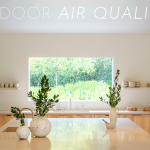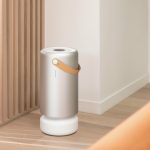In today’s work from home world, we spend a significant amount of time indoors, making it crucial to ensure the air we breathe inside our homes is clean and healthy. Indoor air quality (IAQ) plays a vital role in our overall well-being, as poor air quality can lead to various health issues. Between forest fires, the industrial sector and chemicals in the furniture and textiles in your own home, it is imperative to discuss the steps to check and improve the air quality inside your home, empowering you to create a safe and healthy living environment for you and your loved ones. Let’s dive into Air Quality Check: Indoor Edition.

To begin, it is essential to assess the current air quality in your home. Several indicators can help you gauge the quality of the air you breathe:
- Observe: Pay attention to any visible signs such as mold growth, musty odors, or excessive dust accumulation.
- Monitor: Use indoor air quality monitors or sensors to measure key parameters like temperature, humidity, particulate matter (PM2.5 and PM10), volatile organic compounds (VOCs), carbon dioxide (CO2), and formaldehyde.
- Identify sources: Identify potential sources of indoor air pollutants, including cleaning products, tobacco smoke, pet dander, pesticides, building materials, and inadequate ventilation.

Proper ventilation is essential for maintaining good air quality indoors. Follow these guidelines to enhance ventilation and air circulation:
- Open windows: Regularly open windows and doors to allow fresh outdoor air to circulate, especially when weather conditions permit.
- Exhaust fans: Utilize exhaust fans in kitchens, bathrooms, and other high-humidity areas to remove pollutants and moisture.
- Air purifiers: Consider investing in high-quality air purifiers with HEPA (High-Efficiency Particulate Air) filters to trap airborne particles effectively. Read about our favorite air purifier in our Wellness Design: Air Purification post.

Reducing and controlling indoor pollutants is crucial for improving air quality. Here are some measures you can take:
- Clean regularly: Dust and vacuum your home regularly to minimize the accumulation of allergens, dust mites, and pet dander.
- Avoid smoking indoors: Implement a strict no-smoking policy indoors, as tobacco smoke is a significant source of harmful pollutants.
- Use natural cleaning products: Opt for environmentally friendly and non-toxic cleaning products to avoid introducing harmful chemicals into your living space. Right now, we are loving the products from Safely and Homecourt.
- Proper storage: Store household chemicals, paints, and solvents in well-ventilated areas away from living spaces to prevent their release into the air.
- Manage moisture: Keep indoor humidity levels between 30% and 50% to prevent the growth of mold and mildew.

Heating, ventilation, and air conditioning (HVAC) systems play a vital role in maintaining indoor air quality. Here’s how to ensure they operate optimally:
- Regular maintenance: Schedule professional inspections and maintenance for your HVAC systems, including cleaning or replacing filters, checking ducts for leaks, and ensuring proper airflow.
- Filter replacement: Replace HVAC filters at recommended intervals to prevent the buildup of dust and pollutants.
- Proper sizing: Ensure your HVAC system is appropriately sized for your home to prevent inefficiencies and inadequate air circulation.

Plants can be natural air purifiers and can contribute to a healthier indoor environment. Consider incorporating indoor plants known for their air-purifying properties, such as spider plants, peace lilies, and snake plants. Plus, they add a sense of life in a room while adding beautiful color and texture to a space.
Prioritizing indoor air quality is essential for creating a healthy living environment. By following the steps outlined in this guide, you can effectively assess, monitor, and improve the air quality inside your home. Remember to regularly evaluate your IAQ, maintain proper ventilation, control indoor pollutants, and ensure the proper functioning of your HVAC systems. By taking these measures, you can safeguard the well-being of yourself and your loved ones, promoting a healthier and more comfortable living space.









